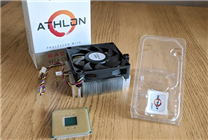The Resurgence of Retro Technology: Intel and AMD Revive Classic Processors
Summary:
- Intel has reintroduced the Core i5-10400, now named Core i5-110, highlighting the revival of older tech in the modern market.
- AMD has brought back the Athlon 3000G, showcasing the longevity of its 14nm Zen architecture.
- Both companies reflect a growing trend toward retro styles in technology, appealing to budget-conscious consumers.
The technology landscape is witnessing a fascinating resurgence of retro-style processors, bridging the gap between legacy designs and modern capabilities. Intel recently made waves by reintroducing the Core i5-10400, rebranded as the Core i5-110, a notable revival of its 14nm 10th generation line. This move underscores the increasing trend of returning to classic tech designs in light of contemporary consumer needs.
In parallel, AMD has also revived its Athlon 3000G, crafted from the same 14nm process and representing the first generation of its Zen architecture. This classic dual-core processor continues to find relevance in today’s market, especially within Japan, making it an intriguing choice for users seeking budget-friendly options without sacrificing essential performance.
A Closer Look at the Athlon 3000G
Originally launched at the end of 2019, the Athlon 3000G has established itself as a staple for entry-level computing. Manufactured by GlobalFoundries, this processor is not only the first of its kind to feature an overclockable Zen architecture but also offers simplicity and affordability.
-
Core Configuration: The Athlon 3000G is equipped with two cores and four threads, offering sufficient power for basic tasks and casual gaming. Its Level 3 cache stands at 4MB, optimizing data flow for improved performance.
-
Frequency and Overclocking: With a default main frequency of 3.5GHz, users can easily overclock this processor to around 3.9GHz, achieving an approximate 10% boost in performance. This flexibility makes it an attractive option for enthusiasts who enjoy squeezing out additional power from their hardware.
- Integrated Graphics: The processor includes a Vega 3 GPU, featuring 192 stream processors, making it capable of handling light graphics tasks without the need for a dedicated graphics card. Coupled with support for DDR4-2666 memory and two PCIe 3.0 slots, it offers a well-rounded platform for basic computing.
Continued Relevance in 2023
One of the most compelling features of the Athlon 3000G is its enduring AM4 socket compatibility, which allows it to integrate seamlessly into a variety of motherboards still popular in the market today. This extended relevance ensures that both newcomers and seasoned users can easily adopt it without significant infrastructure changes.
In a bid to keep the product fresh and appealing, AMD has updated the packaging of the Athlon 3000G in 2023. The new packaging is not only visually engaging but also marks a price drop, now retailing in Japan for 5,790 yen (approximately 278 yuan), making it more budget-friendly than its original launch price.
Market Trends Reflecting Consumer Demand
The recent moves by both Intel and AMD indicate a broader trend in the tech industry toward classic designs that emphasize value proposition. In an era where consumers are increasingly budget-conscious, the revival of older, reliable processors aligns well with current market sentiments.
This trend does not merely reflect a nostalgic inclination; it serves practical purposes as well. Many users prioritize cost-effectiveness and fundamental computing needs over cutting-edge specs that may go unused. The reintroduction of these processors caters to a demographic that values efficiency and reliability over the latest technology.
Conclusion: A Nostalgic but Pragmatic Shift
As the market evolves, the revival of retro-style processors such as Intel’s Core i5-110 and AMD’s Athlon 3000G highlights a significant shift aimed at satisfying consumer demand for affordability and performance.
Both tech giants are tapping into the nostalgia of older architectures while ensuring their offerings remain relevant in a rapidly changing landscape. This not only benefits budget-conscious users but also serves as a reminder that sometimes, the tried-and-true designs hold the most value in today’s tech-driven world.
Whether you’re a casual user or a tech enthusiast, the appeal of these retro processors cannot be understated. As we navigate a constantly evolving marketplace, the return to foundational technologies reminds us that innovation often thrives alongside tradition.








